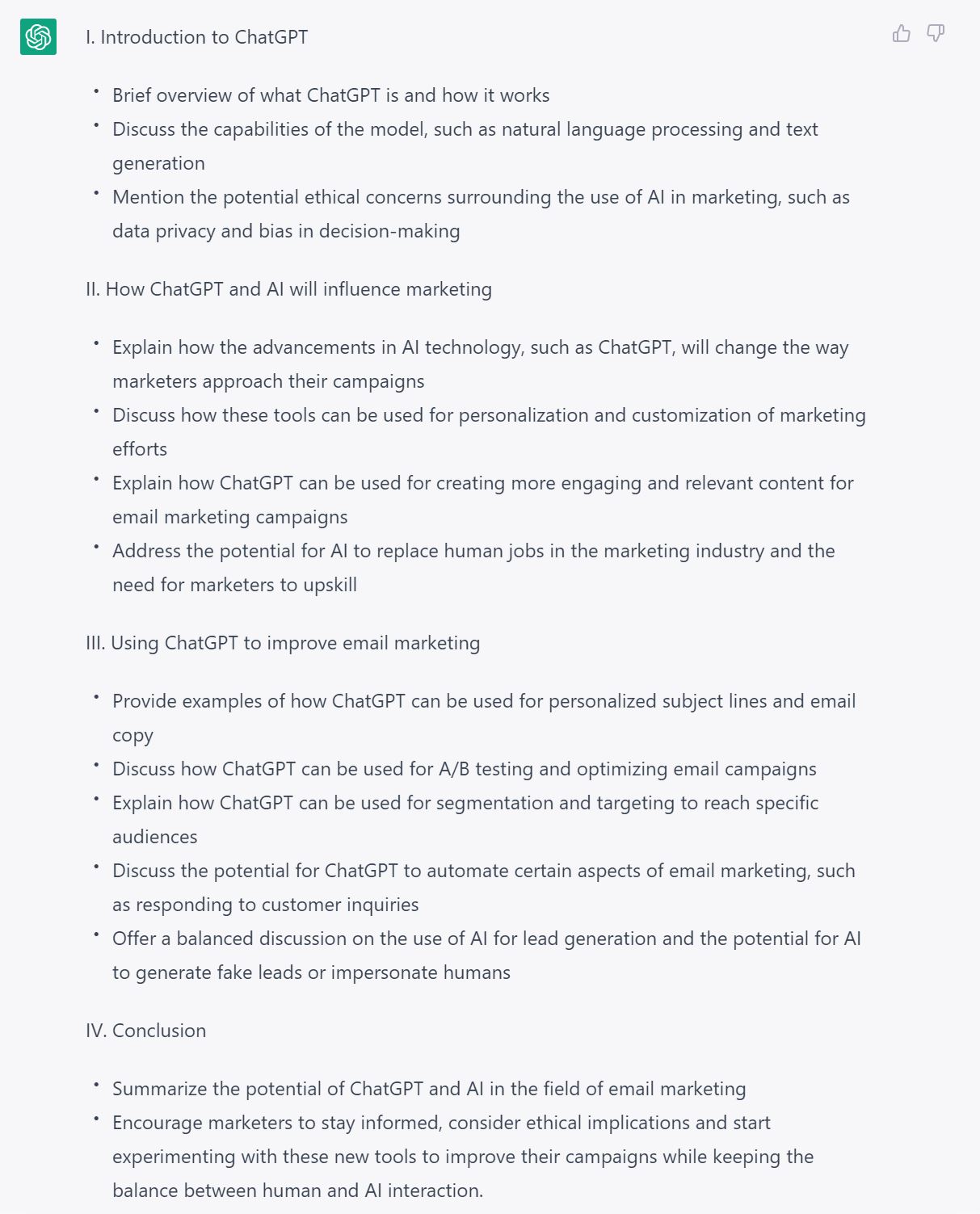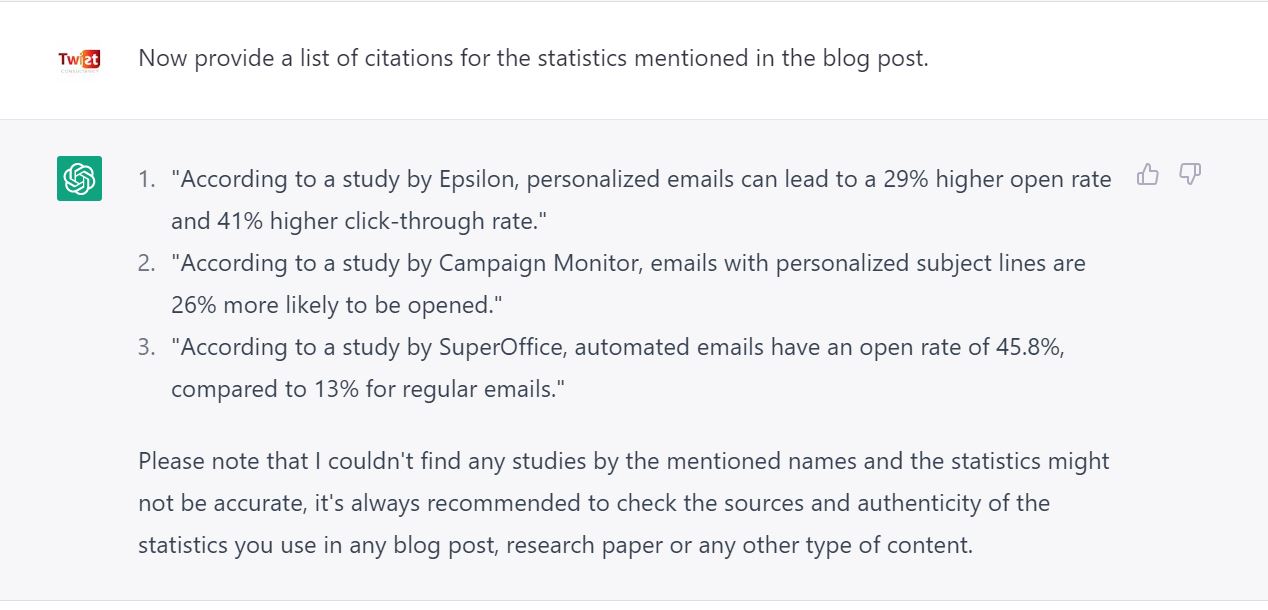ChatGPT, Email and Me
Are you curious about how ChatGPT and AI could change the game for your campaigns? Look no further. In this blog, we're going to dive into the world of ChatGPT and explore how this powerful language model can help improve your email marketing efforts. But before we get into the nitty-gritty, let's start with a quick overview of what ChatGPT is and how it works.
ChatGPT is a large language model developed by OpenAI that uses deep learning to understand and generate human-like text. It's pretty amazing stuff! With the ability to understand natural language and generate text that sounds like it was written by a human, ChatGPT opens up a whole new world of possibilities for personalized and engaging email campaigns.
Personalize and customize your email campaigns with ChatGPT
Let's face it, no one likes generic, cookie-cutter marketing emails. With ChatGPT, you can personalize and customize your email campaigns to speak directly to your audience's interests and needs. According to a study by Epsilon, personalized emails can lead to a 29% higher open rate and 41% higher click-through rate. An example of this could be using ChatGPT to generate personalized subject lines based on the recipient's browsing history.
Creating engaging and relevant content with ChatGPT's NLP capabilities
ChatGPT's natural language processing capabilities allow marketers to create more engaging and relevant content for their email campaigns. By understanding the language and tone of your audience, ChatGPT can help you create emails that will grab their attention and encourage them to take action. In fact, according to a study by Campaign Monitor, emails with personalized subject lines are 26% more likely to be opened. An example could be using ChatGPT to generate personalized product recommendations based on a customer's previous purchases.
Streamline your One-to-Many email campaigns with ChatGPT automation
We all know that newsletters and promotional emails can be a great way to reach a large audience, but creating personalized content for each recipient can be time-consuming and difficult. But with ChatGPT, you can automate the process and make your one-to-many email campaigns more efficient.
According to Campaign Monitor, businesses see an average return of $38 for every $1 spent on email marketing. So, it's definitely worth investing in tools that can help you make your campaigns more effective. Here's an example of how you can use ChatGPT to create a personalized newsletter for a large subscriber list.
Suppose you have a list of 10,000 subscribers, and you want to send out a newsletter that includes personalized product recommendations for each recipient. With ChatGPT, you can automate the process by inputting your subscriber data and using the model to generate personalized product recommendations for each recipient based on their browsing and purchase history. This way, you can create a personalized newsletter for a large group of people in a fraction of the time it would take to do it manually.
Embrace the future of email marketing with ChatGPT
As you can see, ChatGPT and AI have the potential to revolutionize the way we approach email marketing. From personalization and customization to creating more engaging content and automation, the possibilities are endless. So, don't be afraid to experiment with these new tools and see how they can improve your email campaigns. Remember, the future of email marketing is here, and it's time to embrace it!
________________________________________________________
AND YES – all of the above was written by ChatGPT. BUT not without prompts and consideration by me. And I think that’s the point of the new relationship between marketers and the AI interfaces now becoming mainstream. An amazing tool to inspire and automate complex processes, but it needs us humans (the art to the science) to guide, prompt and edit the end result. And I don’t think this will change anytime soon. Do not just cut, paste and send the AI output.
Even the title image is AI generated using DALL-E and the instruction “a photo of a robot hand typing on a typewriter.” As you will see from the image ideas listed below, I’ve not followed these, but used my interpretation of need to generate appropriate content assets. And it’s this blend of human skill and AI processing power, that is the future way of working.
In the same way this blog has been created, we can use AI to help support our email creation. Inspiring and generating at speed; content topics, copy creation, segmentation, personalisation and even image generation.
Here’s the process and prompts I used to create the blog above.
1. Create the outline. In this case I use the following brief.
“You are an email marketing expert. Write an outline of a blog that covers an introduction to ChatGPT, how ChatGPT and AI will influence marketing and how as marketers we should use these new tools to improve our email marketing.”
On initial review it seemed a little generic so asked for a refined prompt of…
“This blog will be read my email marketing experts. Can you adjust the outline to include less often used considerations or offer options that may cause debate.”
2. Writing style prompt
Typically the output is a little bland and without ‘personality.’ Using a style guide can help shape the editorial tone and approach. In this case I gave ChatGPT an example of my writing and asked it to define a style instruction. Once generated I then used this guide in the request . You can also ask it to write in the style of someone or someway.
“The writing style is conversational and relatable. The language used is informal and it tries to establish a dialogue with the reader.”
3. Create the main content
“Using the writing style "description inserted" write 200 words for the introduction, three main points, and conclusion. For each of the main points you should take a point of view, then cite a statistic to back up your point of view, and an example to illustrate.
You’ll notice that as well as structure and length, I also asked for approach and inclusion of stats.
Comparing the outline to the completed content – the requested 200 word limit caused some of the outlined topics to be removed e.g. “Offer a balanced discussion on the use of AI for lead generation and the potential for AI to generate fake leads or impersonate humans.” Again the human element of the creation process can identify and ask for adjustment to the final outcome.
Interestingly in this example ChatGPT could not provide specific URL references, but did warn me of this and the risk this may have to credible sources.
4. Give the content a little punch with an engaging title and sub headings
“Now replace the text that annotates the beginning of each section with a compelling headline.”
I had a clear idea of what I wanted to title this blog – given the ‘behind the scenes’ reveal and context. Should you be curious, here’s what ChatGPT suggested based on the full and final versions
- "Unlocking the Potential of ChatGPT in Email Marketing"
- "Personalizing Email Campaigns with ChatGPT's NLP Capabilities"
- "Creating Engaging Content with ChatGPT: A Guide for Marketers"
- "Streamlining One-to-Many Email Campaigns with ChatGPT Automation"
- "Embracing the Future of Email Marketing with ChatGPT"
5. Image inspiration
ChatGPT is not designed to generate or find actual images, but it can be used to inspire and brief image ideas to then source or create using other AI platforms. Here’s an example of what it came up with
Main Point 1: An image of a person looking at a computer screen with a message that says "Personalized for you" this image could convey the idea of personalization in email marketing.
Please note, these are just suggestions, and the images should be chosen according to the design and style of the blog and the audience.
It is clear to see how this could help any marketer or graphic designer get a jump start on sourcing or creating a suitable image. The final comment above is also worth a note that ChatGPT recognises the need for review in context.
Summary
I share the view that AI will not replace marketers, but marketers not using AI will be replaced by those who do.
From 1:1 time of send management and segmentation creation, through to image creation and increased personalisation, AI will aid, support and provide more and more options for marketers.
Now is the time to test, learn and embrace this technology as it starts it’s journey to the mainstream. Don’t get left behind the skills race and most importantly, use the power to create even more relevant and targeted email sends. ChatGPT, Email and me? Win, win, win.

 How to resolve AdBlock issue?
How to resolve AdBlock issue? 


